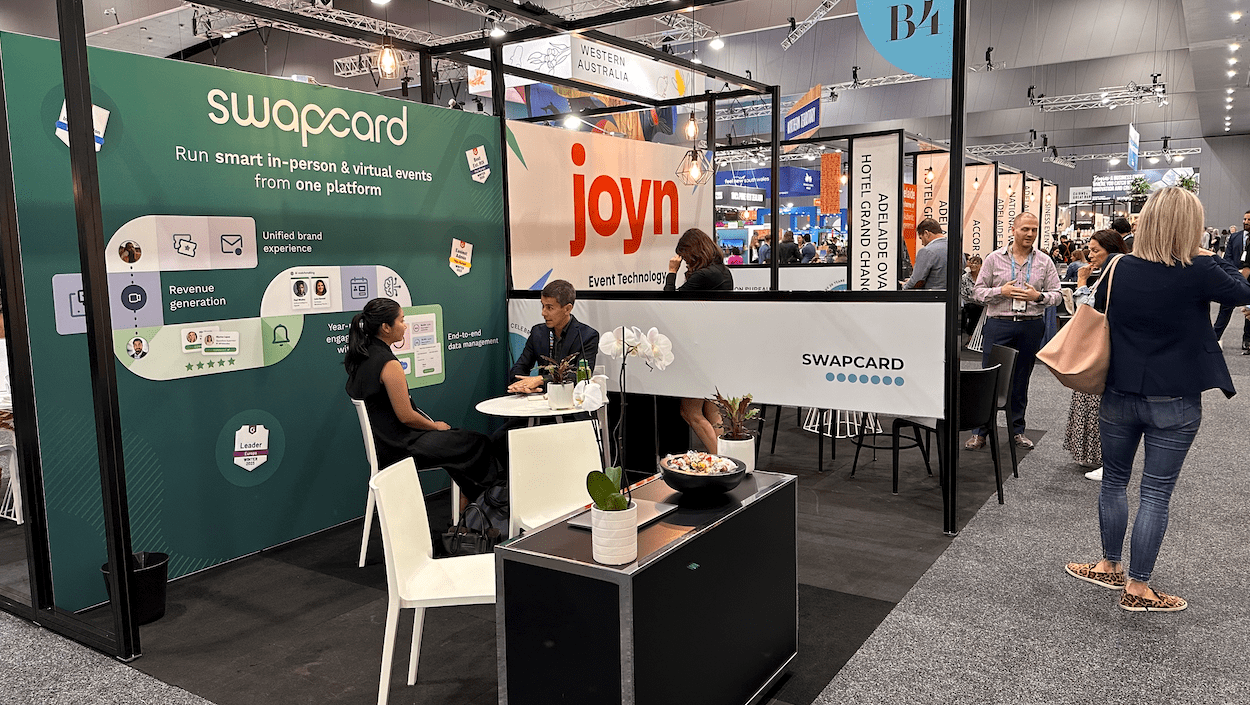Making every dollar count has always been important, but amidst a global economic crisis, rising venue costs, profitability pressures, and changing expectations among attendees and sponsors, mastering the art of budgeting has never been more critical.
Effective budgeting is all about knowing where to invest and where to cut costs. One expenditure that's increasingly making its case for a strategic investment is event technology. However, selecting the ideal event solution is far from straightforward. The market is saturated with platforms and tools, each offering diverse features and often accompanied by complex pricing models.
We’re here to help you unravel these complexities so you can choose the best solution for your trade show - without breaking the budget.
Why invest in event tech?
The events industry has undergone a series of changes in recent years. From the surge in virtual and hybrid platforms during the pandemic to a resurgence of in-person experiences once again, the way we host and attend trade shows has fundamentally evolved. Amidst these shifts, one constant remains: the compelling need to invest in event technology.
Event tech refers to any platform or tool that is designed to enhance the planning, execution, and experience of events. It's the key to unlocking what we call "smart events" — using technology to elevate event experiences, irrespective of the format.
.png?width=1520&height=618&name=In-Article%20(19).png)
Embracing event tech has several key benefits:
- Opens up new avenues for engagement and participation: Event technology introduces creative methods to engage and include attendees. Interactive elements such as real-time surveys, virtual networking opportunities, and gamification turn passive spectators into engaged participants.
- Enhances data-driven decision-making: Event technology improves data-driven decision-making by offering insightful data on attendee behavior, preferences, and feedback. Organizers can use this data to optimize ROI and future event performance.
- Streamlines event logistics: Automation and digital technologies simplify event planning and management tasks, minimizing manual labor and the likelihood of errors. Event tech also enhances logistics, making operations smoother at every stage of the registration process.
- Expands reach: With the assistance of event technology, individuals from across the globe can now attend and actively participate in events. Some event tech platforms also allow you to extend the longevity of an event by transforming one-time events into year-round communities.
- Boosts branding and marketing: Event technology helps organizers increase their brand presence and efficiently reach their target audience by delivering personalized experiences and tailored communication.
- Improves cost-efficiency: Although event technology requires an initial investment, it can result in significant cost savings over time. Reduced printing, travel, and venue expenses are examples of how technology can make events more cost-effective.
As you can see, event tech isn't just a choice; it's a strategic imperative that allows you to accomplish your event goals.
Now that we've established the importance of embracing event technology, let's delve into the specifics of event platform pricing models. Understanding how these pricing models work is fundamental to making an informed decision as to which platform to invest in.
Event Platform Pricing Models
The event platform pricing landscape is diverse, featuring tiered pricing, pay-per-feature models, subscription-based plans, and even free options with add-ons. Understanding these pricing strategies will allow you to reap the benefits of event technology without breaking the budget.
Skift’s Event Technology analyzed 60+ tech platforms and released a report packed with insights on everything from pricing to response times.
Haven’t got time to read the full report? No sweat, here’s a recap on the pricing models offered today.
.png?width=1520&height=618&name=In-Article%20(18).png)
The majority of event platforms (27%) use a pricing model that is based on the number of participants. The second most popular pricing model (23%) is a fixed price based on defined tiers (basic, enterprise, and pro). Another well-liked option (21.3%) is a base pricing model with the option to add additional features a la carte.
8.2% of suppliers offer bespoke pricing, which can be a pain when trying to get a quick quote.
Some providers combine several of these options for a truly personalized offering. An example would be setting the initial fee based on the number of participants and adding more services at a later date.
Let's break down five of the most popular pricing models on the market today.
1. Subscription-Based Event Platforms
What is it?
Subscription-based pricing takes first place in the event platform pricing model popularity contest. These models give organizers like yourself access to must-have features and the flexibility to scale up or down as the needs of your event evolve.
Event platforms structure their offerings into tiered subscription plans. Each tier comes with varying levels of features, customization, and support. Organizers can cherry-pick a plan that aligns perfectly with their event's scale and complexity.
The subscription universe comprises monthly and annual plans. While annual commitments frequently result in cost savings, monthly agreements offer flexibility.
Who should use it?
With its flexibility and scalability, subscription-based event systems are appropriate for various trade show events, from large expos to niche conferences and those with fluctuating or evolving needs.
Example
You can see it used by event tech solutions such as Accelevents and Splash. In the case of Swapcard, there’s the Starter Plan for smaller events needing fundamental digital elements and the Pro Plan for larger events requiring advanced capabilities and dedicated support.
2. The Freemium Model
What is it?
A freemium pricing model offers a basic version of a product or service for free, with advanced features available for a fee. Its purpose is to attract cost-conscious users with a no-cost entry point and then convert them into paying customers by showcasing the benefits of its premium features and functionalities.
Who should use it?
The freemium model appeals to organizations that prioritize cost-effectiveness, flexibility, and experimentation in their event planning endeavors. It serves as a strategic entry point that provides essential features at no cost, making it an attractive option for a wide range of event organizers, from small-scale events where keeping costs down is a priority to early-stage startups looking to experiment with event technology without incurring significant upfront expenses.
Example
Cvent is one of the few all-in-one platforms that offers a free plan. Organizers and exhibitors can thoroughly test a platform's capabilities without constraints like time limits or the need for immediate commitments.
.png?width=711&height=289&name=In-Article%20(30).png)
3. Pay-Per-Use Model
What is it?
The pay-per-use pricing model is a transaction-based approach that offers ultimate flexibility. Organizers are billed according to the number of users using the platform or the number of events they host. On certain platforms, you have the option for even more personalized pricing, where you are billed solely for the services or features you utilize.
Who should use it?
The pay-per-use model is an excellent choice for event organizers seeking flexibility, cost-effectiveness, and scalability. It's particularly well-suited for irregular, niche, or growing events, as well as those with customized needs. This model ensures that you only pay for what you use, making it an excellent choice for those looking to optimize their event budget while accessing essential event platform services.
Examples
There’s no shortage of tools on the market that offer this pricing model. Invent, Jubila, and EventMobi are three well-known examples. EventMobi is an event management software that prides itself on its flexibility. Its pricing is based on the total number of attendees. Swapcard's pricing falls under the pay-as-you-go category, as above a certain threshold, it charges per visitor or exhibitor. In this model, subscribers are incentivized for large purchases, and they also have the flexibility to carry forward unused credits upon renewal.
.png?width=1520&height=618&name=In-Article%20(21).png)
4. Commission-Based
What is it?
With a commission-based pricing model, companies charge a percentage or fixed fee for ticket sales or transactions based on the value of sales, partnerships, or sponsorships generated through their event platform or services. This instills a sense of shared responsibility and mutual benefit. Companies earn from users' success, driving them to offer better services. Users benefit from cost-effectiveness, paying only when they achieve results.
Who should use it?
The commission-based pricing model fits events where revenue generation is inherently unpredictable, as it ensures that users only pay when they achieve measurable results. It's especially well-suited for events based on forming strategic partnerships and securing lucrative sponsorship deals. This model effectively caters to a broad range of businesses and industries, making it an attractive option for events where revenue may fluctuate. However, desire for financial efficiency is still there.
Example
Eventbrite employs a diverse pricing model that encompasses a commission-based structure, along with additional service and transaction fees.
.png?width=1520&height=618&name=In-Article%20(20).png)
5. Performance-Based
What is it?
Users are charged depending on particular criteria relating to the success of their event rather than paying a flat fee or a commission on sales. These metrics may differ, but they frequently consider elements like the quantity of attendance, the volume of leads produced, the degree to which attendees are engaged, or other quantifiable key performance indicators (KPIs).
Who should use it?
This model is ideal for organizers who want to align their investment closely with the platform's tangible impact on their events and are confident that the platform can deliver the desired results. It can be particularly attractive for those looking for a cost-effective option that directly ties platform fees to the value they receive.
.png?width=1520&height=618&name=In-Article%20(23).png)
Factors Influencing Event Platform Costs
Now that we've explored the various pricing models let's delve into the myriad factors that influence the overall cost of an event platform.
1. Event size
The scale of your event has a significant impact on expenditures. Larger events that require considerable logistics, complex schedules, and high-profile speakers might incur a more substantial bill. It's only natural that as your event experiences more success, your budget will need to increase accordingly.
2. Features and Functionalities
Each added feature, whether it's advanced analytics, virtual reality experiences, or enhanced networking tools, contributes to the overall expense. Event platforms with extensive customization options and comprehensive reporting capabilities come with a higher price tag.
Additionally, the complexity of features and the extent of integration with other systems can impact costs. But more does not always mean better. Carefully consider your specific needs and objectives when selecting features and functionalities to ensure you strike the right balance between cost and value.
3. Event Type: Virtual, In-Person, or Hybrid?
Each format has unique requirements and considerations that can significantly impact your budget. Virtual events, for instance, may require robust online infrastructure, sophisticated streaming capabilities, and interactive features, which can influence pricing.
In-person events may focus more on venue logistics, registration, and on-site engagement tools. Hybrid events call for a flexible, all-in-one platform that can meet the demands of a wide range of attendees.
.png?width=1520&height=618&name=In-Article%20(24).png)
4. Complexity
As events become more complex (higher number of sessions, diverse attendee needs, and intricate scheduling requirements), the demands on the platform increase. To accommodate these complexities, platform prices can increase extensively.
5. Support and Additional Services
Premium support often includes extended service hours, weekend support, or even on-site assistance, which are often reflected in event platform prices.
Support agents may need specialized training to handle complex technical issues, increasing the cost of workforce training and development. They may also require the use of advanced helpdesk software, customer relationship management systems, or other tools to track and manage support requests effectively.
.png?width=711&height=289&name=In-Article%20(29).png)
Hidden Costs & Considerations in Event Platforms
The upfront cost of an event platform is essentially the starting point of your financial commitment, meaning it typically serves as a baseline rather than the final price tag. That's why you should approach the selection of an event platform with a keen awareness of the potential hidden costs or additional fees that may come into play for various services and features beyond what's included in the initial offering.
1. Payment Processing Fees
Payment processing fees, which can vary widely depending on factors like the payment provider, transaction volume, and payment type, are generally not included in upfront pricing for event platforms. This is due to the variable nature of these fees and the involvement of third-party payment gateway providers.
Separating payment processing costs allows for transparency, flexibility, and the ability to choose the most suitable payment solution. Unfortunately, third-party payment gateway costs can be erratic, so it's good to get a clear breakdown of these expenses to plan and budget accurately.
2. Integration and Data Migration
The overall cost of using event technology can be significantly impacted by data migration between platforms and integration of an event platform with other tools, systems, or databases. The complexity of integration, the need for custom development, and the volume of data to be moved all add to the final cost of your event platform.
.png?width=711&height=289&name=In-Article%20(28).png)
3. Customization and Branding Investments
Event organizers often seek to tailor the platform to their unique event identity, whether through branding alignment, user interface customization, or specific functionality development. These investments can enhance the attendee experience and help your event stand out from the competition. However, they also come with additional costs that should be carefully considered when budgeting for your event.
4. Training and Onboarding
Embracing a new event platform can present complexities and consume valuable time. To expedite the process and ensure a seamless transition, many organizations opt to invest in training sessions and dedicated onboarding support for both their event planning team and attendees. These training programs allow you and your attendees to make the most of your event platform and save time.
.png?width=1520&height=618&name=In-Article%20(27).png)
Summary
As you prepare for your event, keep in mind that effective budgeting involves making strategic investments. A well-chosen event platform can significantly boost attendee engagement, maximize sponsorships, and ultimately increase your revenue. However, it's crucial to delve into the nuances of event platform expenses and uncover hidden costs to ensure the financial stability of your event strategy. Your event platform is more than just a tool; it's a valuable partner in accomplishing your event objectives.
Are you searching for a user-friendly event platform to enhance your revenue streams? Our friendly team would love to help you find the right solution to your event needs.
.png)
.png?width=1520&height=618&name=In-Article%20(17).png)


.png)







